
Royal Botanic Gardens, Kew is a non-departmental public body in the United Kingdom sponsored by the Department for Environment, Food and Rural Affairs. An internationally important botanical research and education institution, it employs 1,100 staff. Its board of trustees is chaired by Dame Amelia Fawcett.
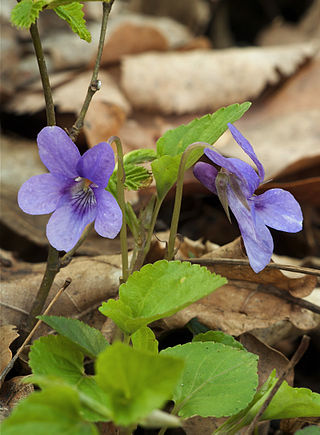
Viola is a genus of flowering plants in the violet family Violaceae. It is the largest genus in the family, containing over 680 species. Most species are found in the temperate Northern Hemisphere; however, some are also found in widely divergent areas such as Hawaii, Australasia, and the Andes.
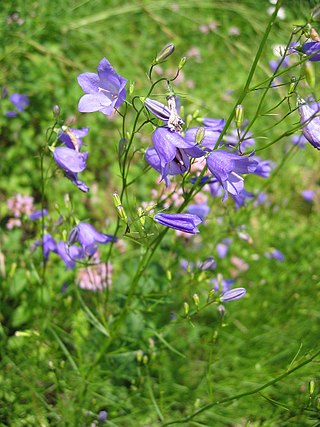
Campanula rotundifolia, the harebell, Scottish bluebell, or bluebell of Scotland, is a species of flowering plant in the bellflower family Campanulaceae. This herbaceous perennial is found throughout the temperate regions of the northern hemisphere. In Scotland, it is often known simply as bluebell. It is the floral emblem of Sweden where it is known as small bluebell. It produces its violet-blue, bell-shaped flowers in late summer and autumn.

Scilla luciliae is a species of flowering plant in the family Asparagaceae. It is referred to by the common names Bossier's glory-of-the-snow or Lucile's glory-of-the-snow, and is a bulbous perennial from western Turkey that flowers in early spring. After flowering, it goes into dormancy until the next spring. The specific epithet is in honour of Lucile, the wife of the Swiss botanist Pierre Edmond Boissier (1810-1885). It belongs to a group of Scilla species that were formerly put in a separate genus, Chionodoxa, and may now be treated as Scilla sect. Chionodoxa.

Jubaea is a genus of palms with one species, Jubaea chilensis, commonly known in English as the Chilean wine palm or Chile cocopalm, and palma chilena in Spanish. It is native to southwestern South America and is endemic to a small area of central Chile between 32°S and 35°S in southern Coquimbo, Valparaíso, Santiago, O'Higgins, and northern Maule regions.

Viola canadensis is a flowering plant in the Violaceae family. It is commonly known as Canadian white violet, Canada violet, tall white violet, or white violet. It is widespread across much of Canada and the United States, from Alaska to Newfoundland, south as far as Georgia and Arizona. It is a perennial herb and the Latin-specific epithet canadensis means of Canada.

Viola sororia, known commonly as the common blue violet, is a short-stemmed herbaceous perennial plant native to eastern North America. It is known by a number of common names, including common meadow violet, purple violet, woolly blue violet, hooded violet, and wood violet.

Viola kitaibeliana, the dwarf violet, is a plant species in the genus Viola. It is native to a large area from the Canary Islands, across Europe, to northern Iran and southern Turkmenistan.
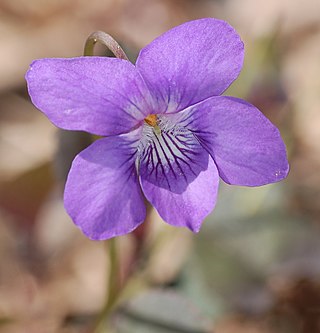
Viola labradorica, commonly known as alpine violet, American dog violet, dog violet or Labrador violet, is a perennial herbaceous flowering plant. It is native to Greenland, eastern Canada, and the eastern United States. The plant sold as Viola labradorica by nurseries is Viola riviniana.
The Plant List was a list of botanical names of species of plants created by the Royal Botanic Gardens, Kew and the Missouri Botanical Garden and launched in 2010. It was intended to be a comprehensive record of all known names of plant species over time, and was produced in response to Target 1 of the 2002–2010 Global Strategy for Plant Conservation, to produce "An online flora of all known plants". It has not been updated since 2013, and has been superseded by World Flora Online.

Viola libanotica is a species of flowering plant in the Violaceae family. It is referred to by the common name Lebanon violet and is an evergreen running herb. It is endemic to the cold heights of Lebanon. The plant has dark green leaves. The flowers are purple.
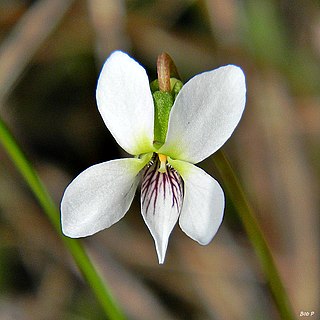
Viola lanceolata, commonly known as lance-leaved violet or bog white violet, is a small group of stemless white-flowered violets. It is an ornamental plant in the Violaceae family, part of the genus Viola. It gets its name from its lanceolate leaf shape and from the habitats in which it thrives.

Suaeda vera, also known as shrubby sea-blite, shrubby seablight or in the USA sometimes as alkali seepweed, is a species of flowering plant in the family Amaranthaceae. It is a small shrub, with very variable appearance over its wide range. It is a halophyte, and occurs in arid and semi-arid saltflats, salt marshes and similar habitats.
Euphorbia hispida is a species of flowering plant in the family Euphorbiaceae, native to Afghanistan, Bangladesh, India, Iran, Kuwait, Pakistan and Western Himalaya. It was first described by Pierre Edmond Boissier in 1860.
Viola angustifolia is a species of flowering plant, in the genus Viola.

Schweiggeria is a genus of flowering plants in the violet family Violaceae, with one or two species, found in eastern Brazil.

Noisettia is a genus of flowering plants in the violet family Violaceae, with a single known species.
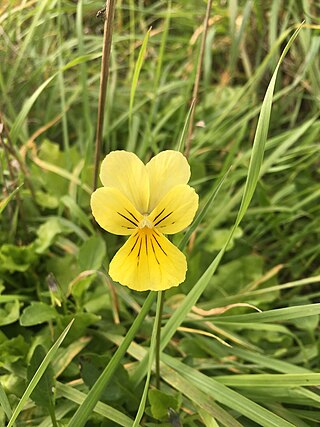
Viola lutea subsp. calaminaria is a subspecies of V. lutea, in the violet family, the Violaceae. The plant occurs from Kelmis in the Belgian province of Liège across the borders to Germany and the Netherlands. The plant has adapted to an excess of zinc in the tailings of a former mines, the heaps of stone left over after separating the valuable fraction of ore. By evolving the ability to cope with the toxic heavy metal pollution, this violet has gained an advantage over the other plants in the ecosystem, as is able to become the locally dominant floral component of such habitats.

Viola jooi, the Carpathian violet or Transylvanian violet, is a species of flowering plant in the family Violaceae, native to Romania and Ukraine. It is a relict species of calcicolous rock outcrops.

Viola gracilis, also known as the Olympian violet, is a species of flowering plant within the family Violaceae.

















